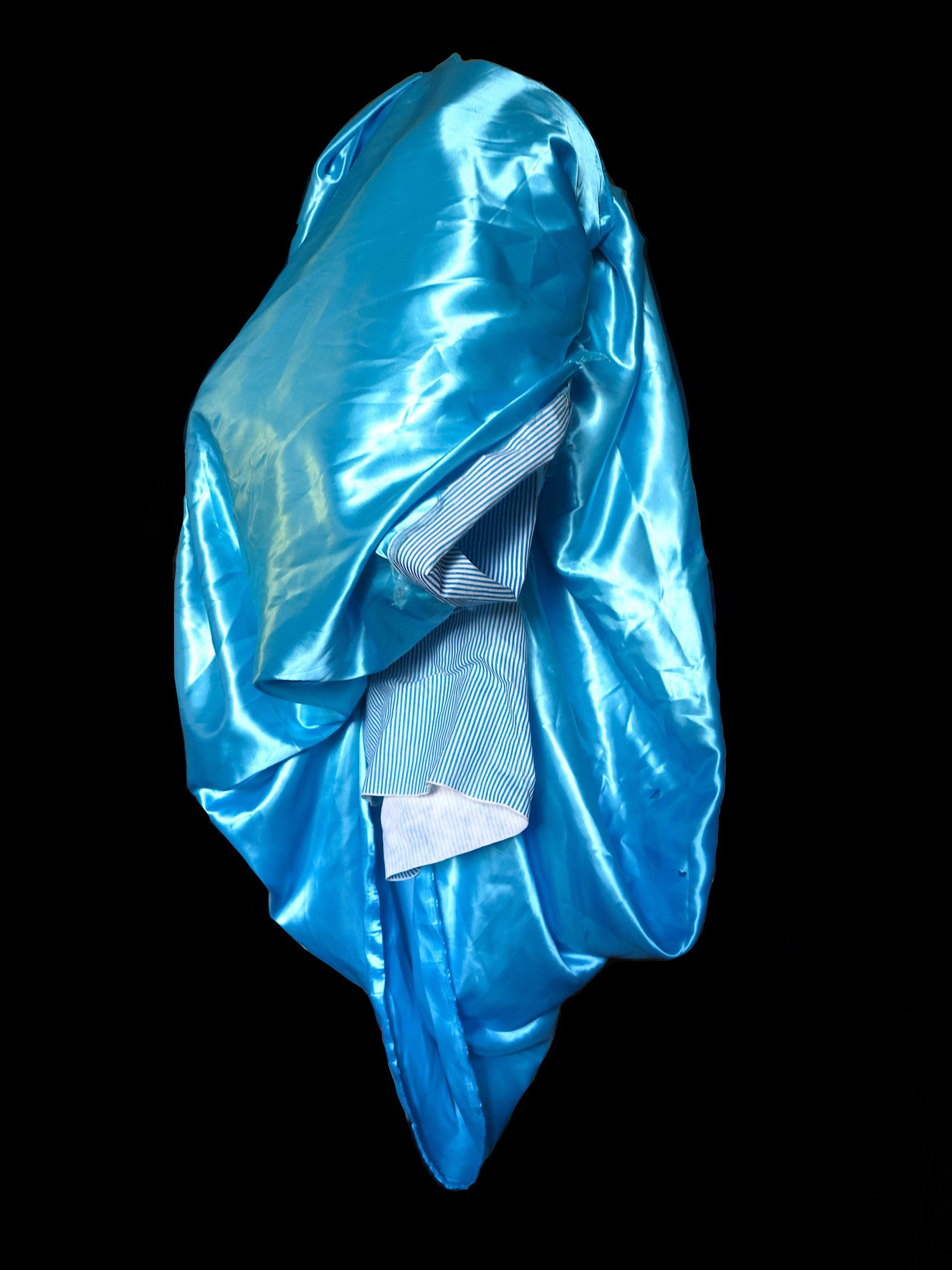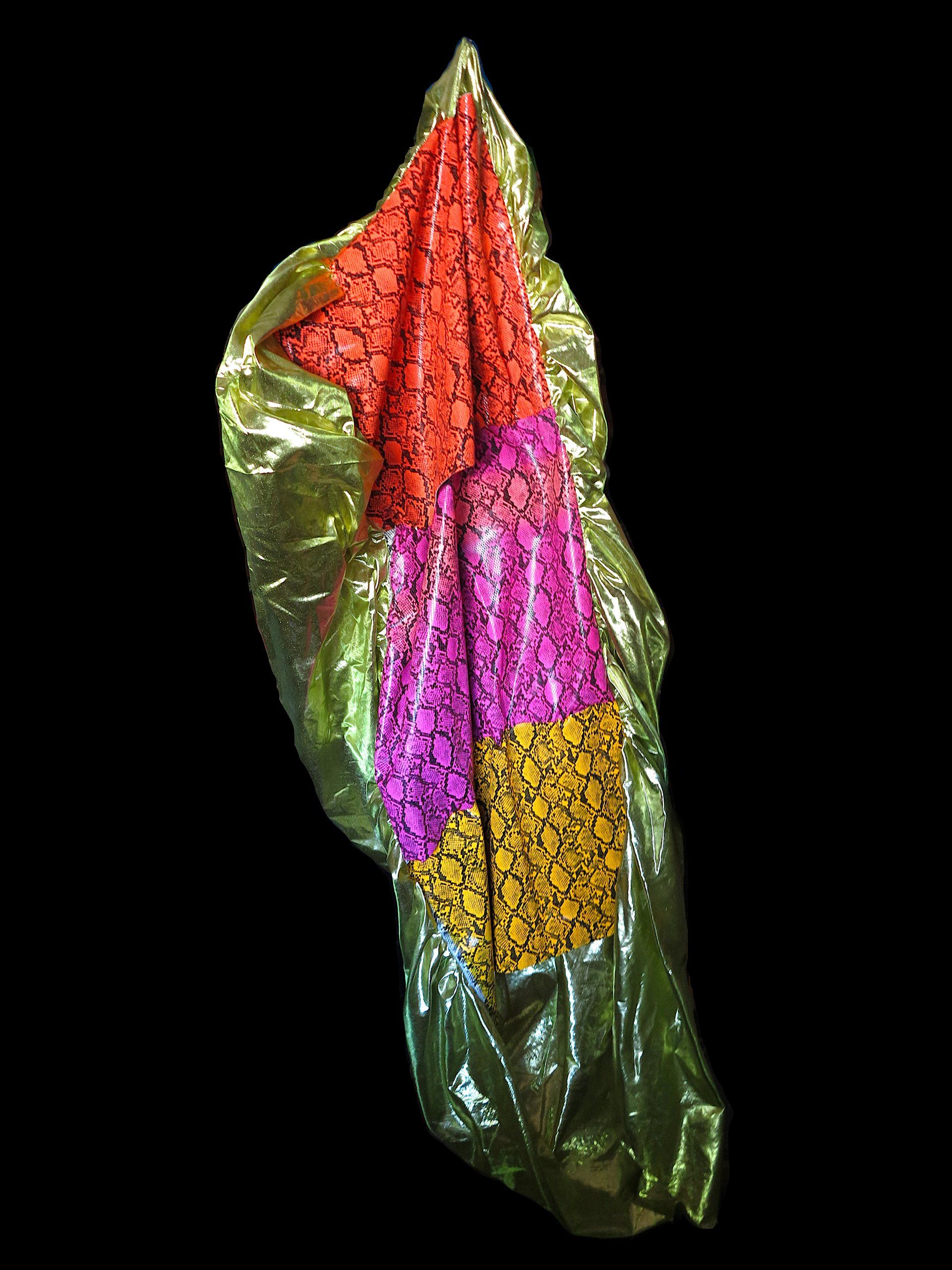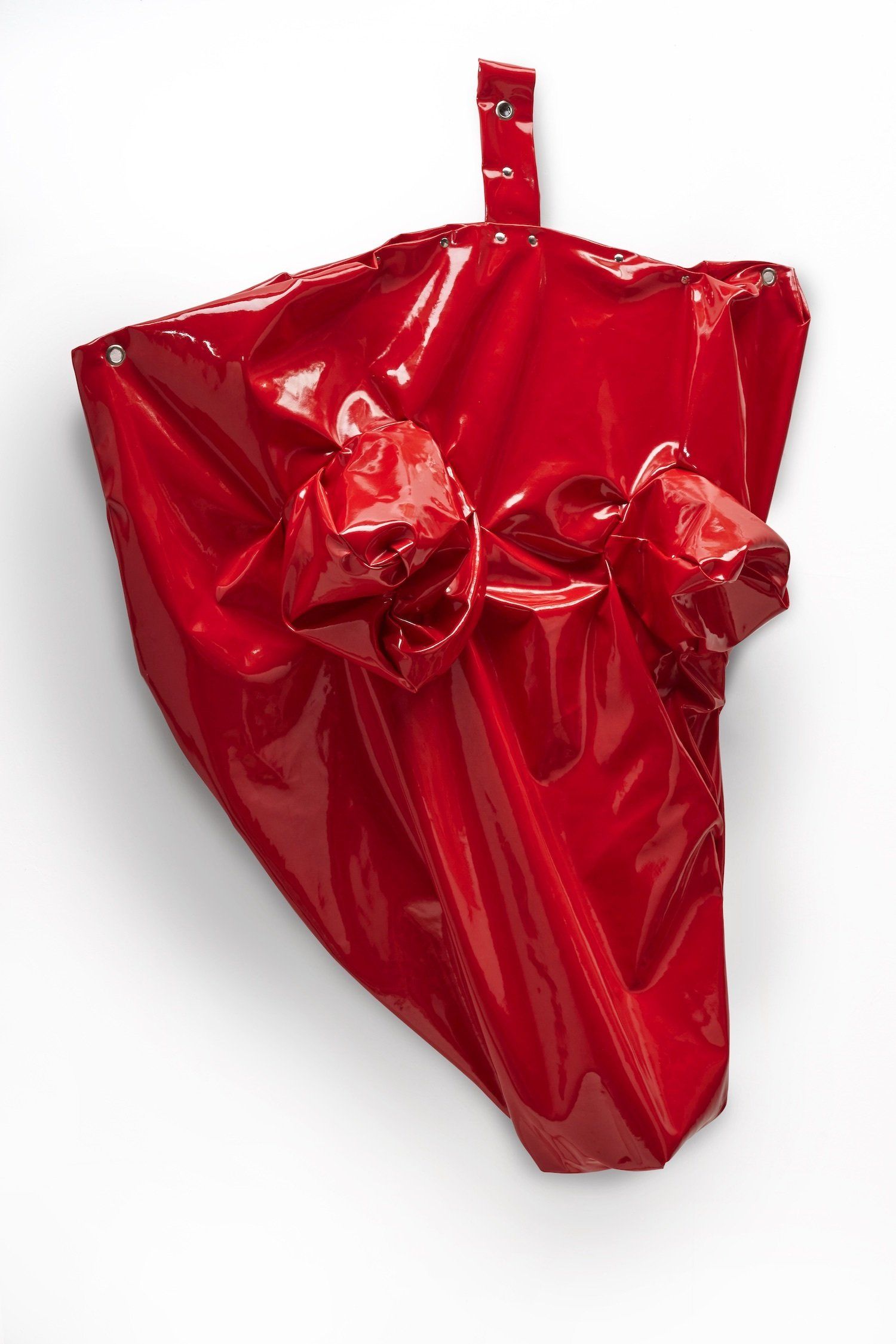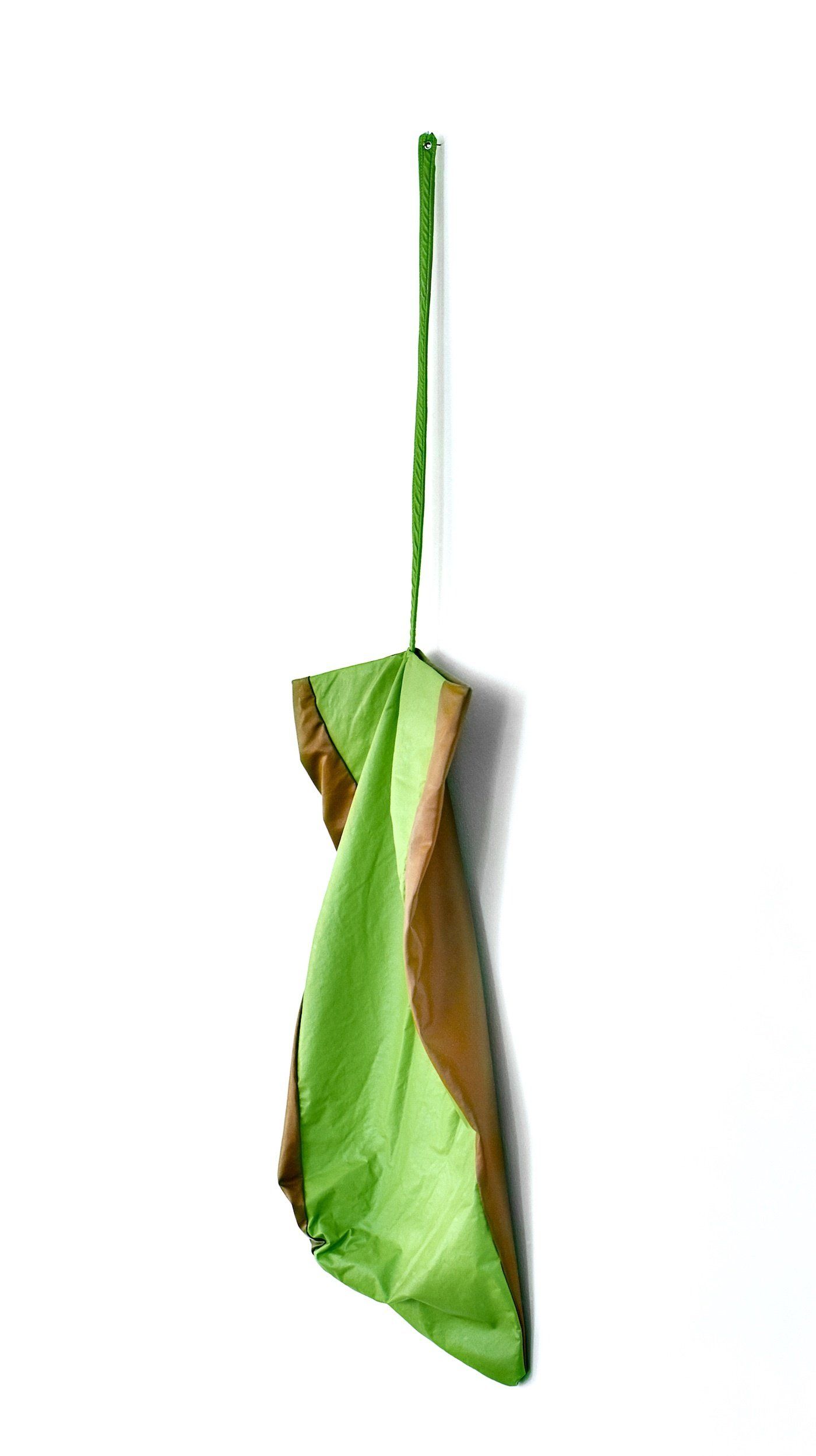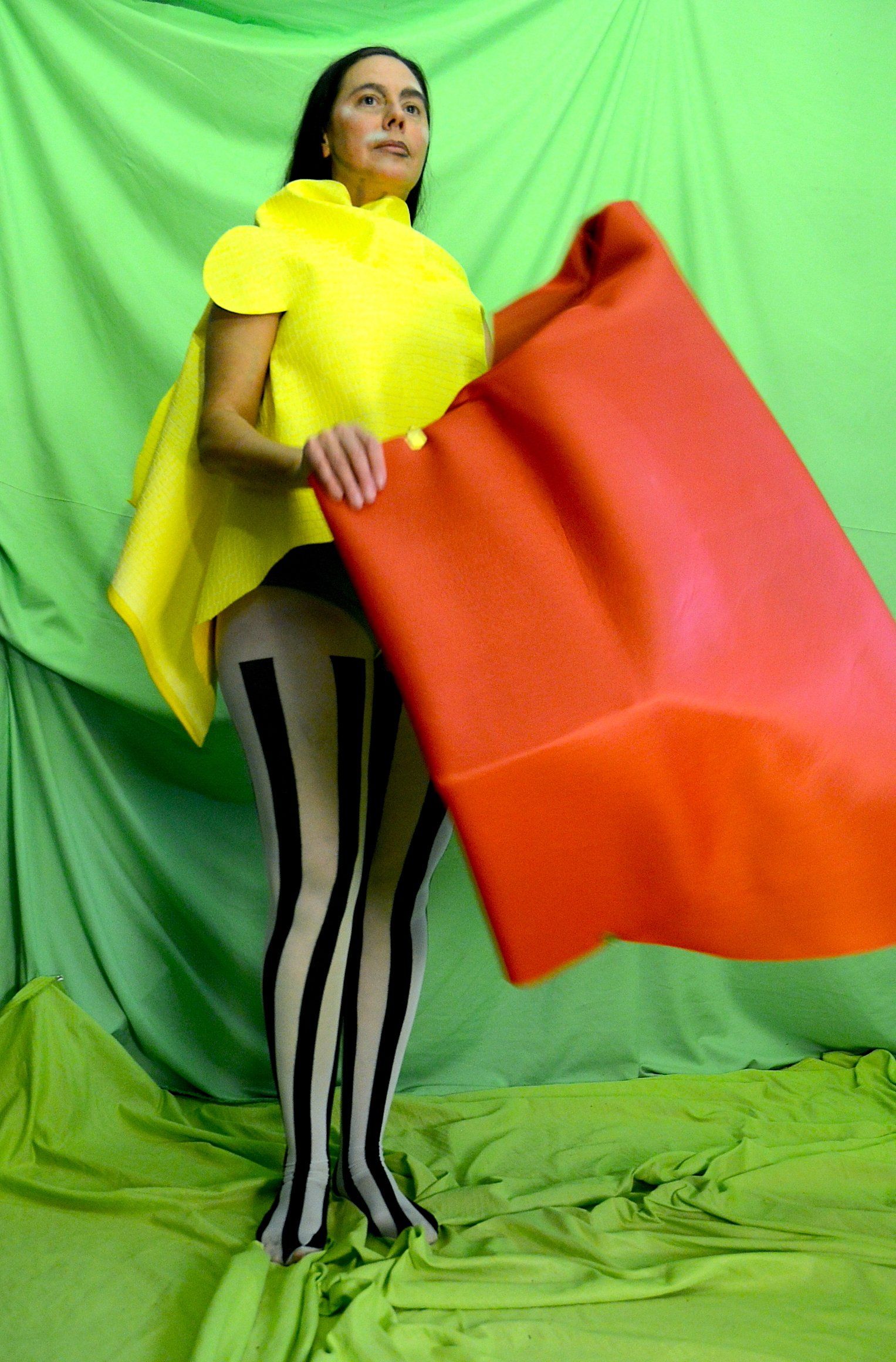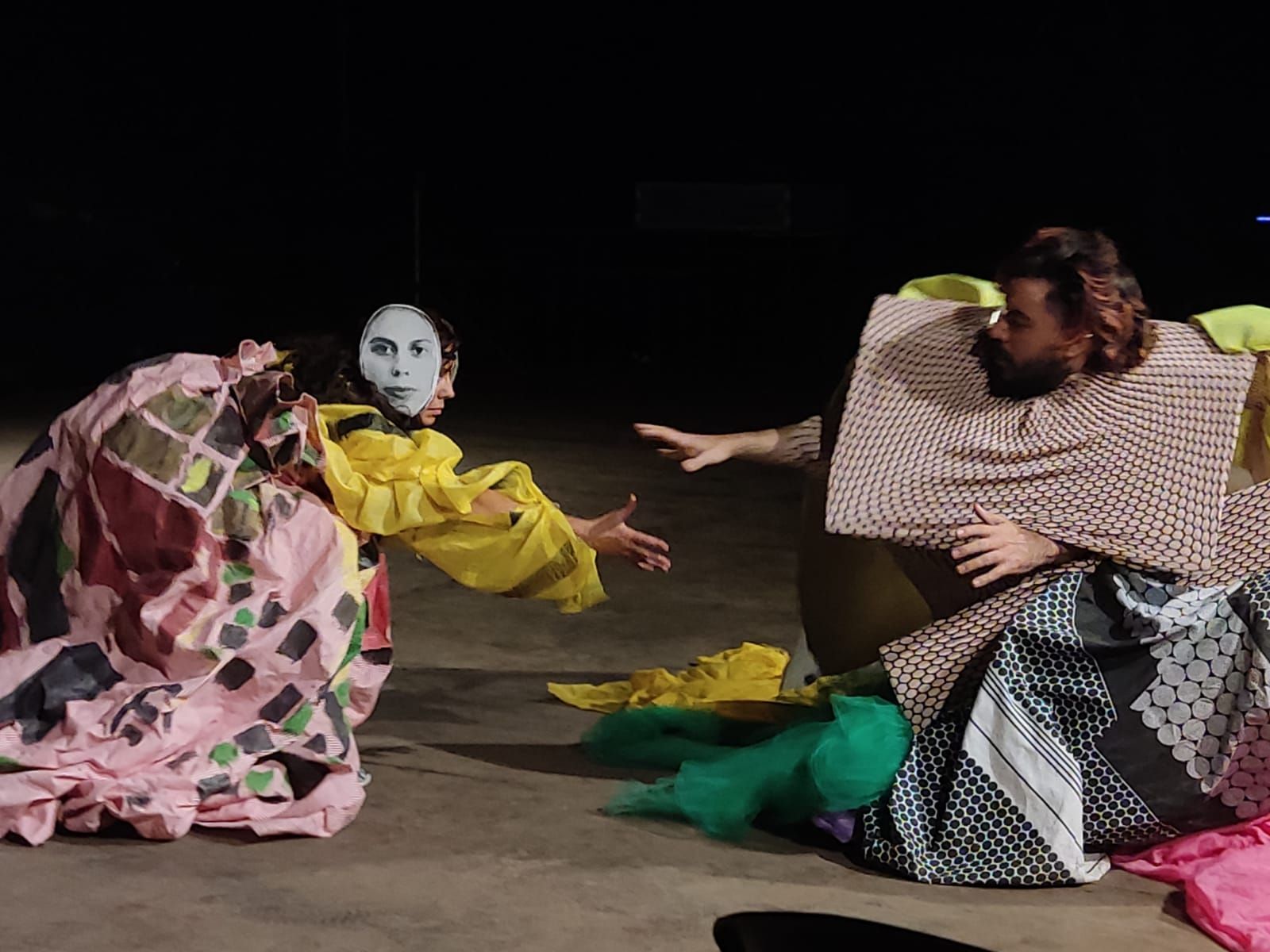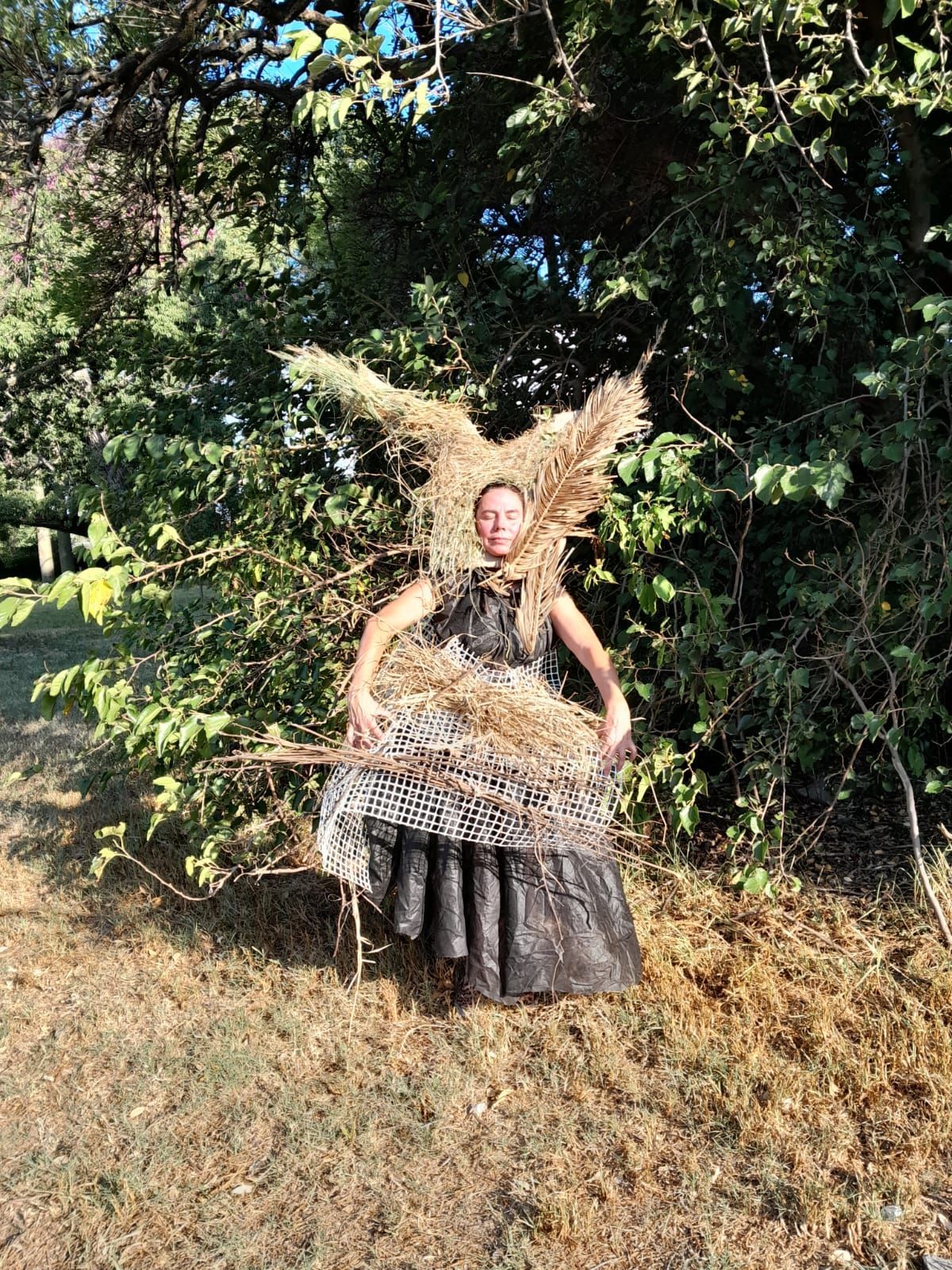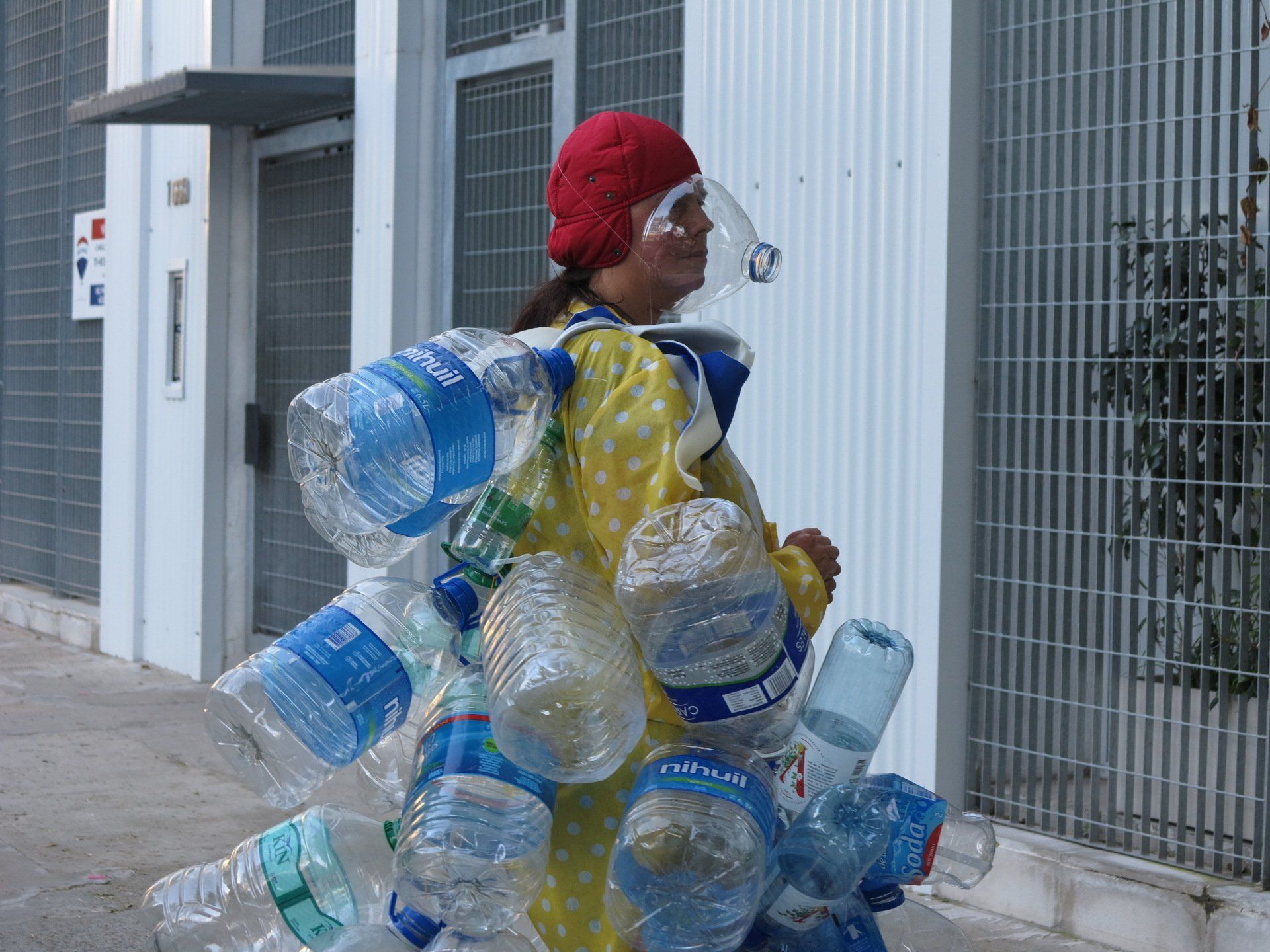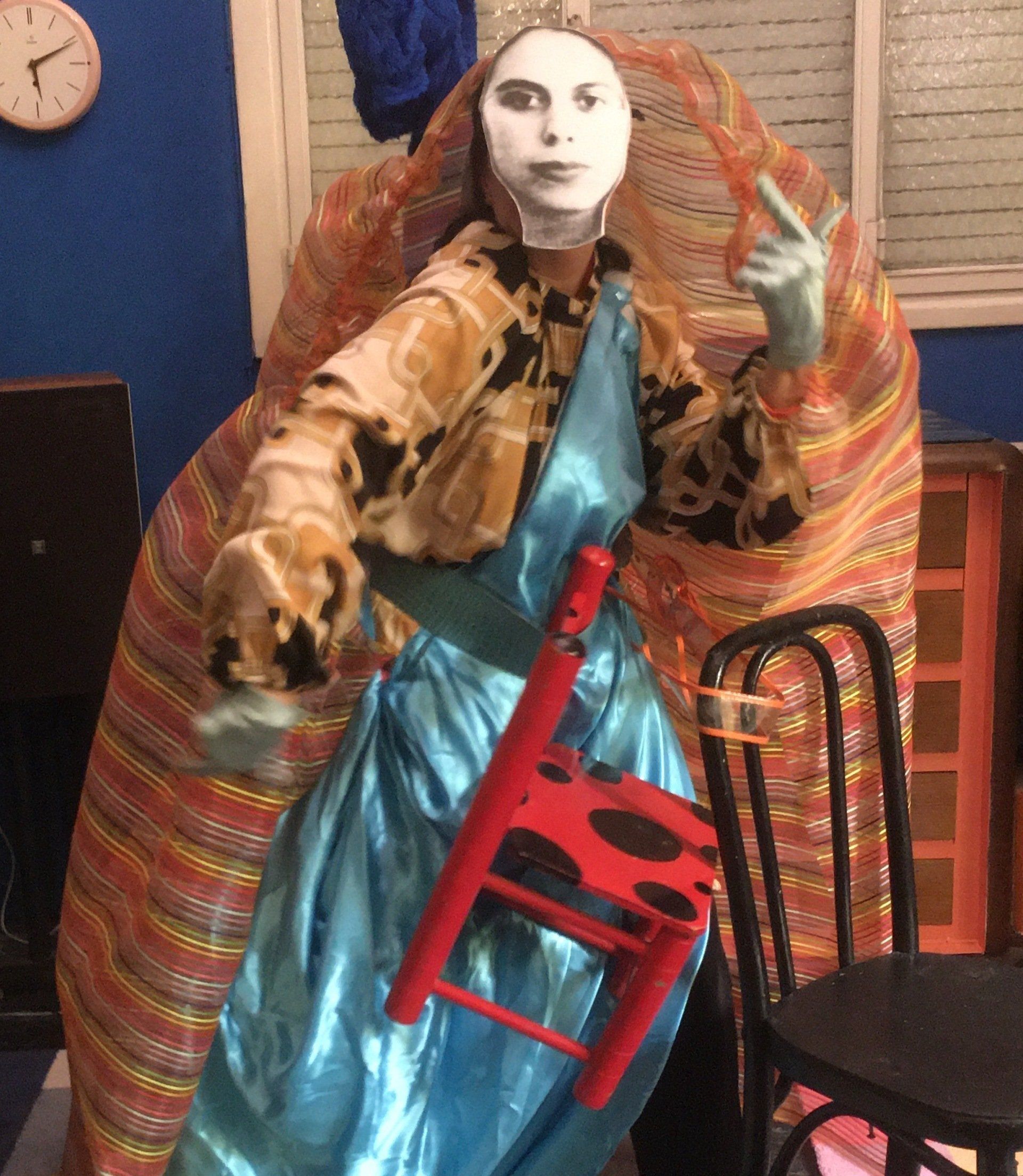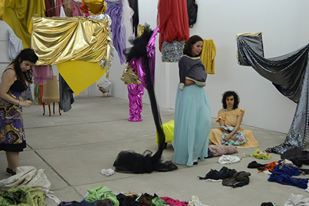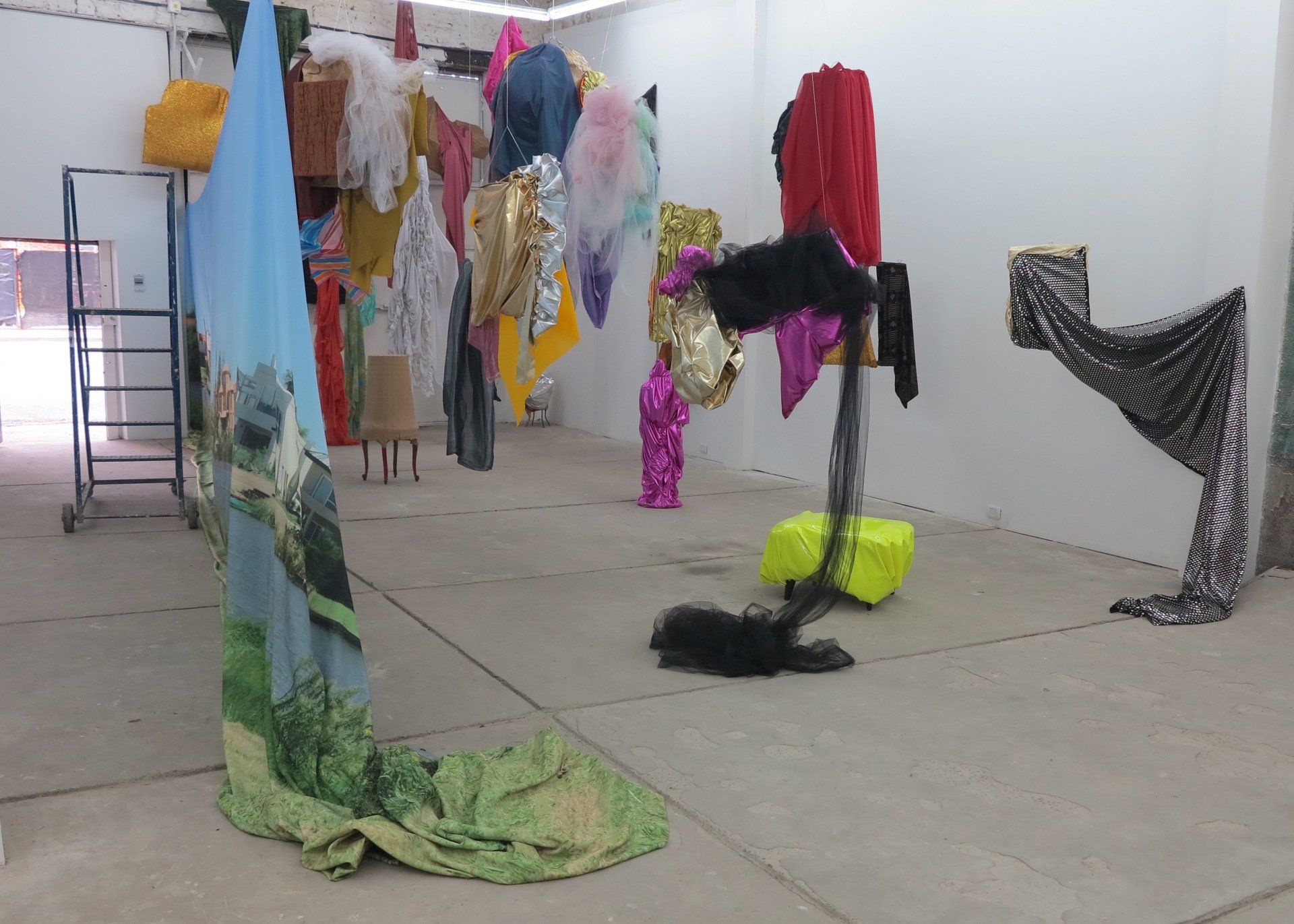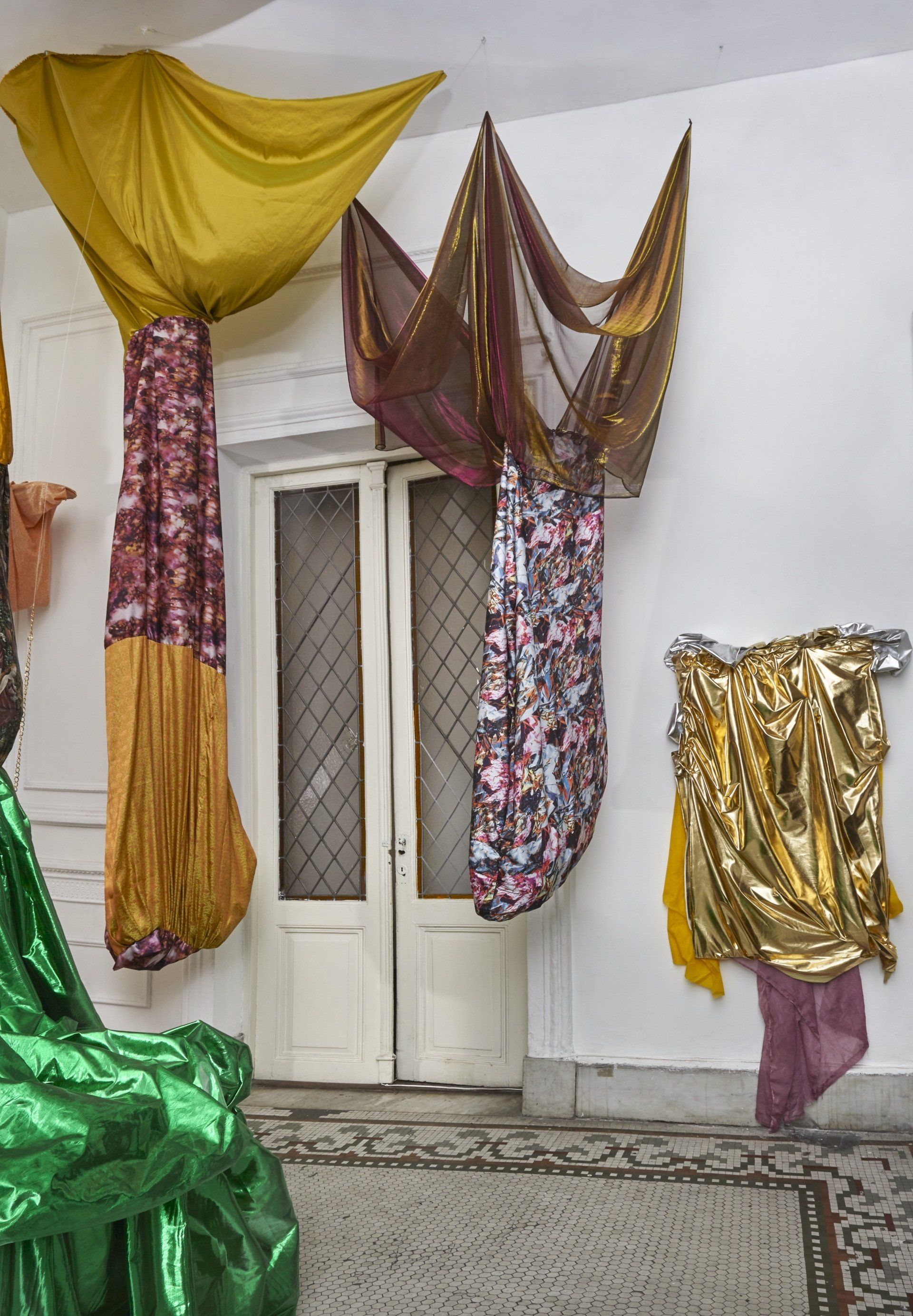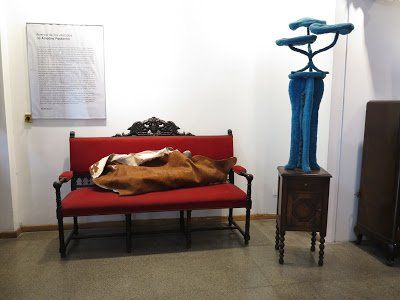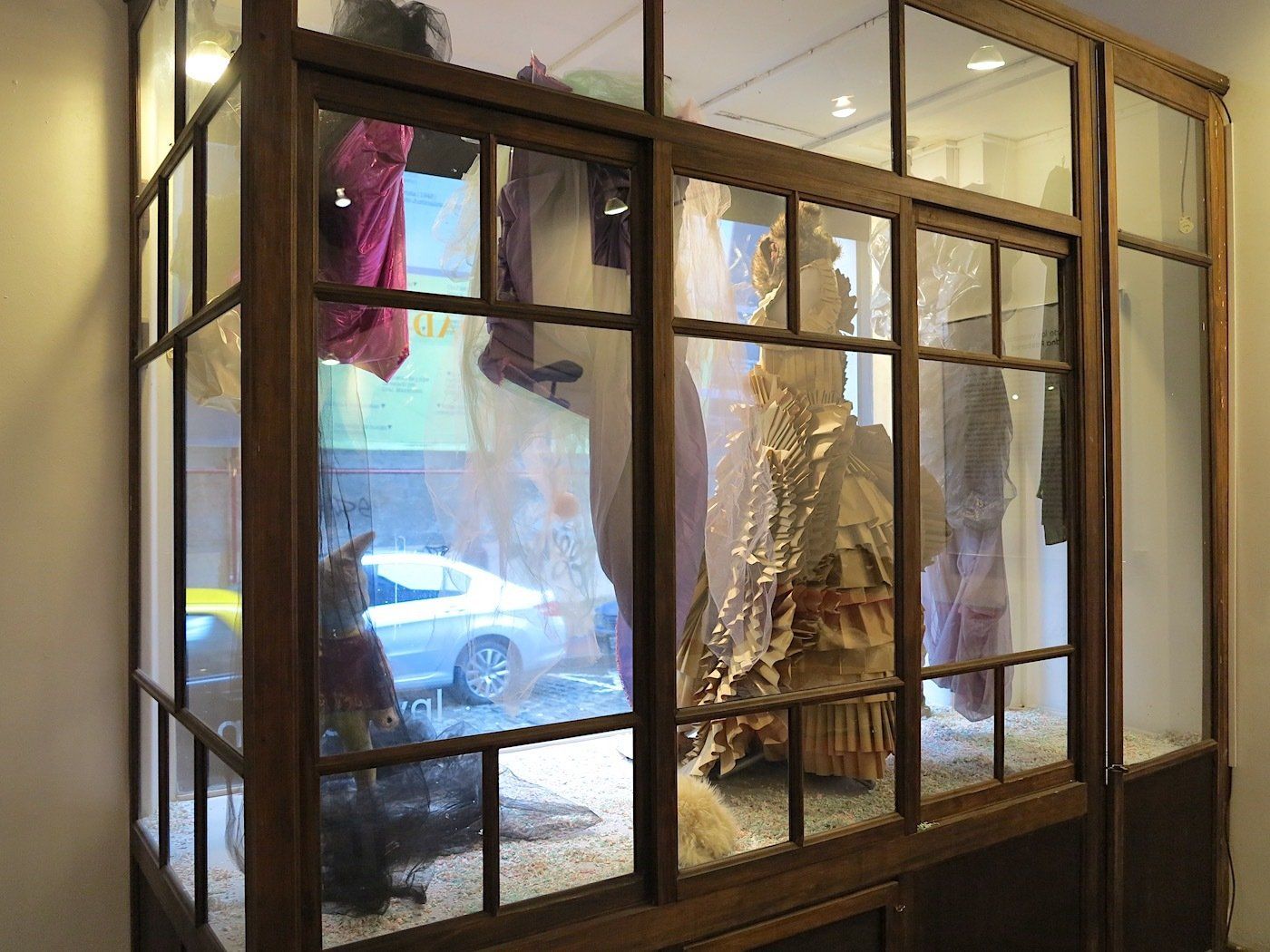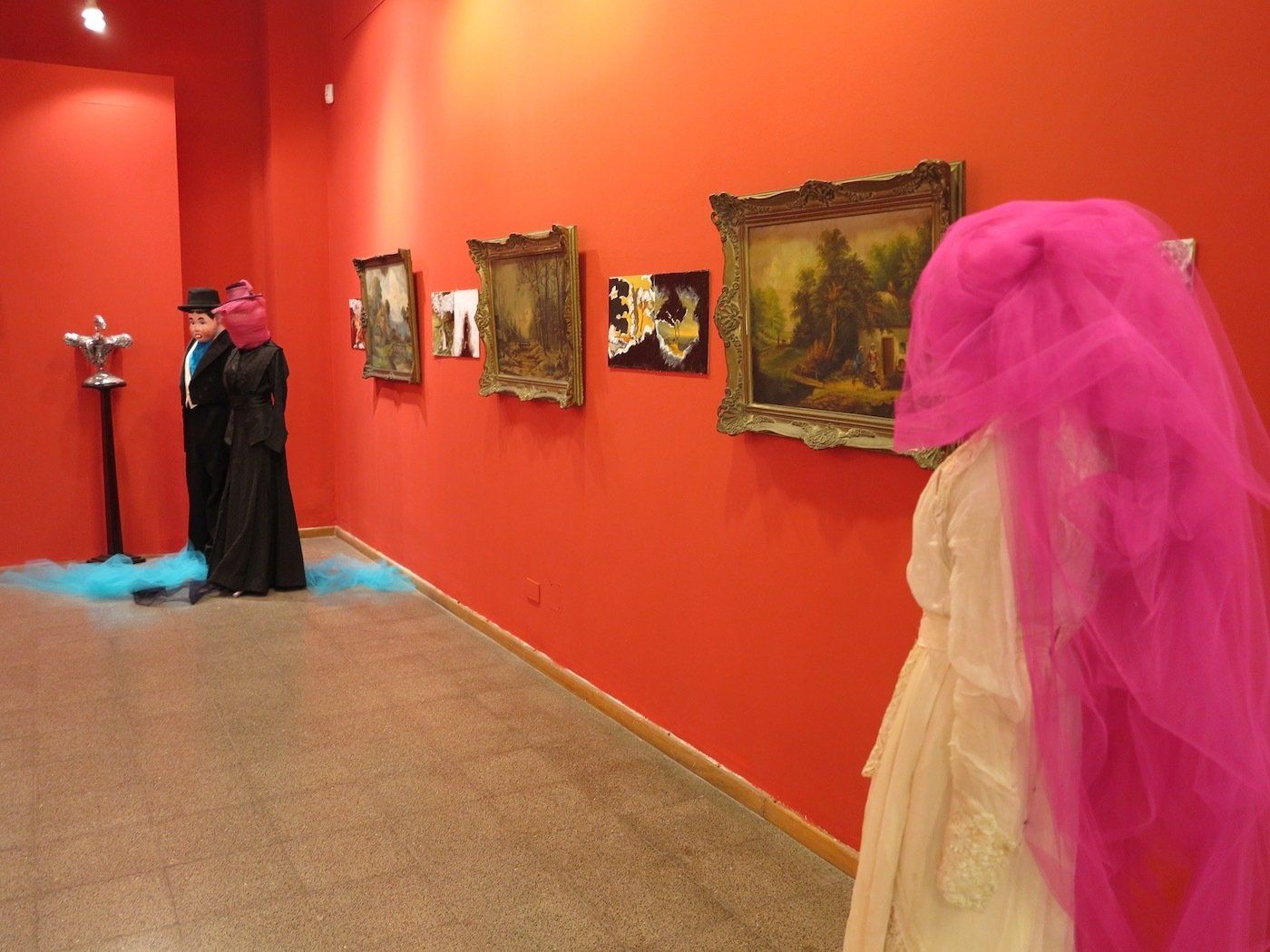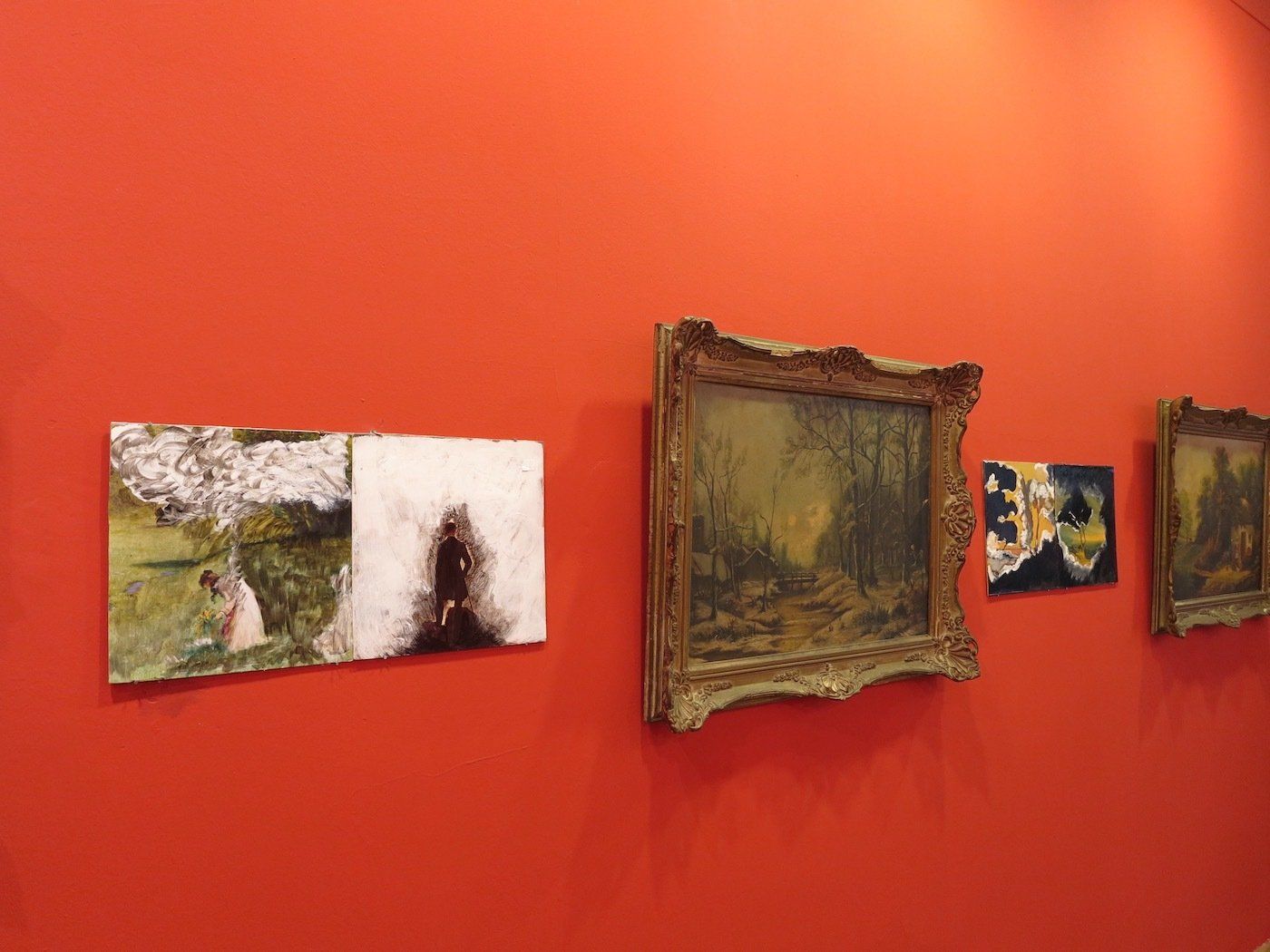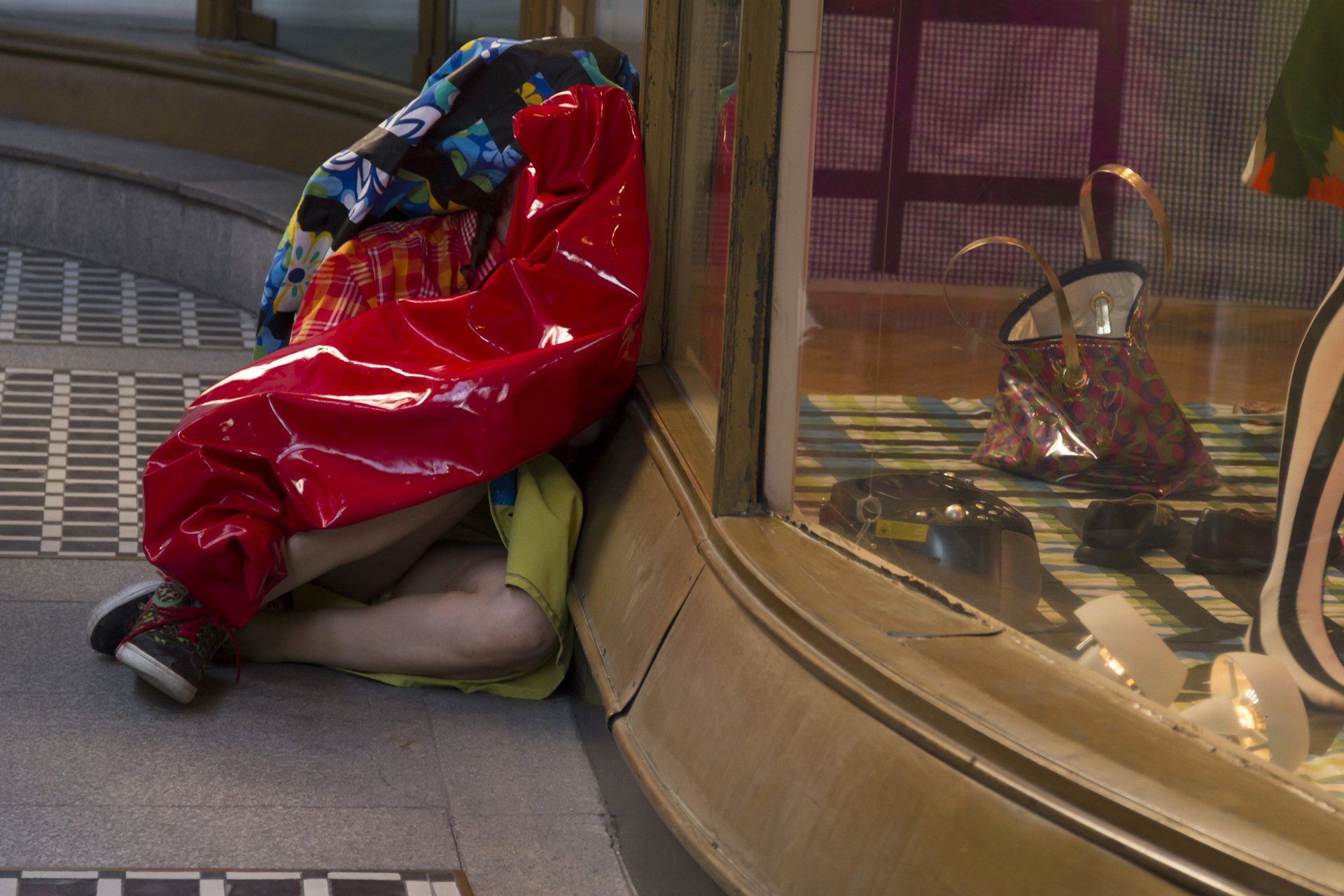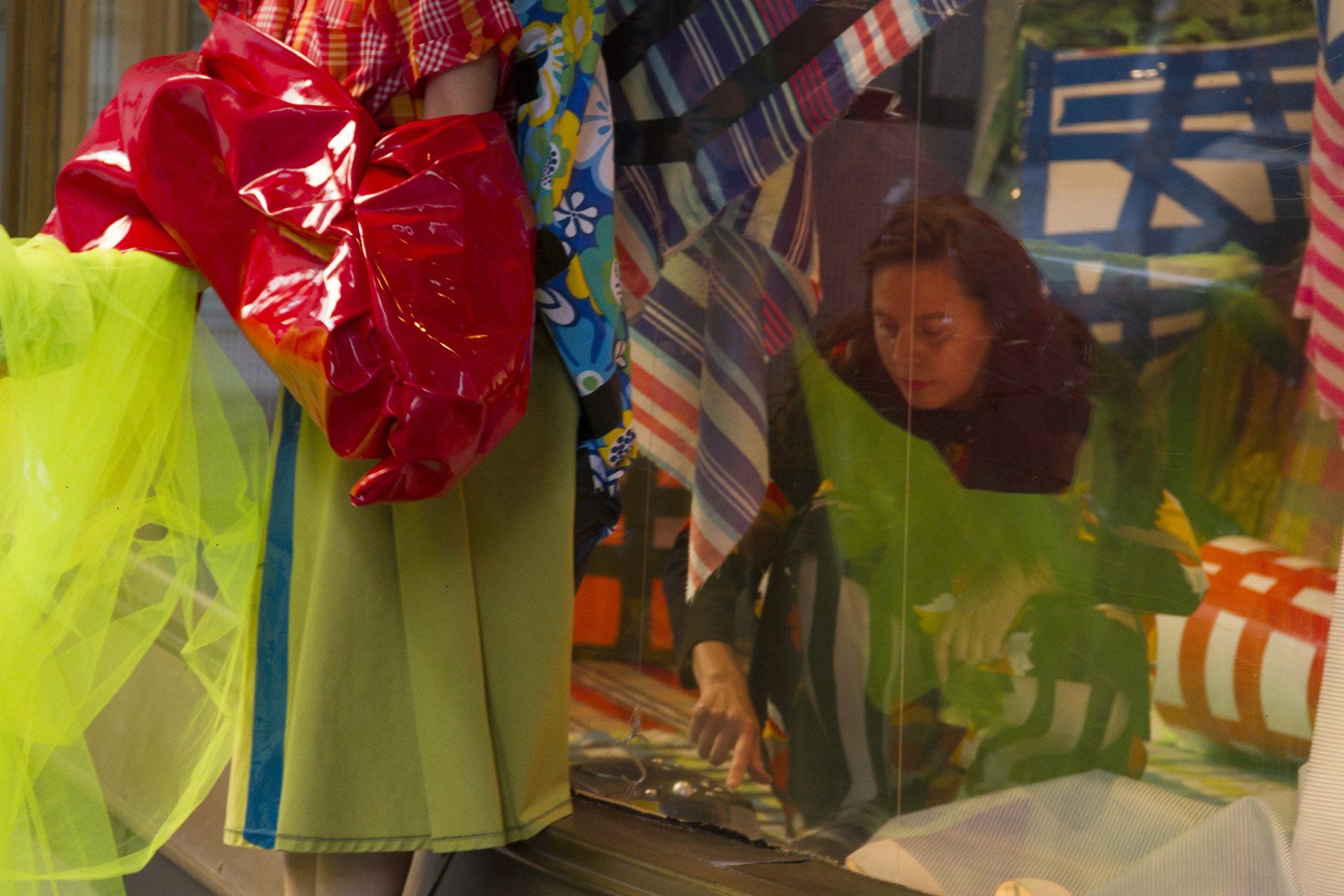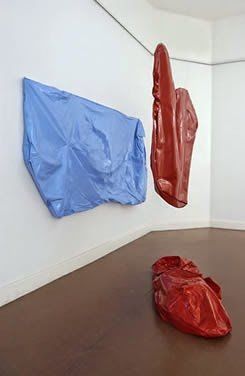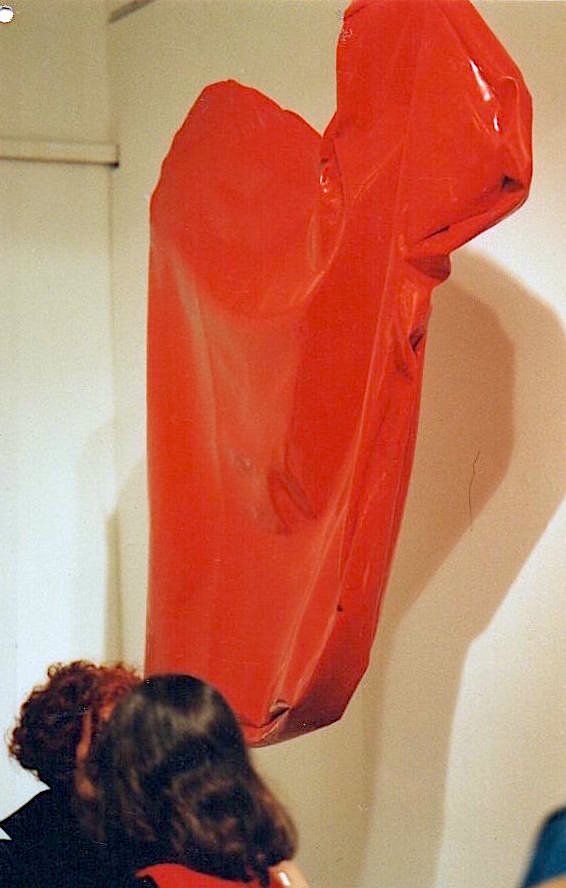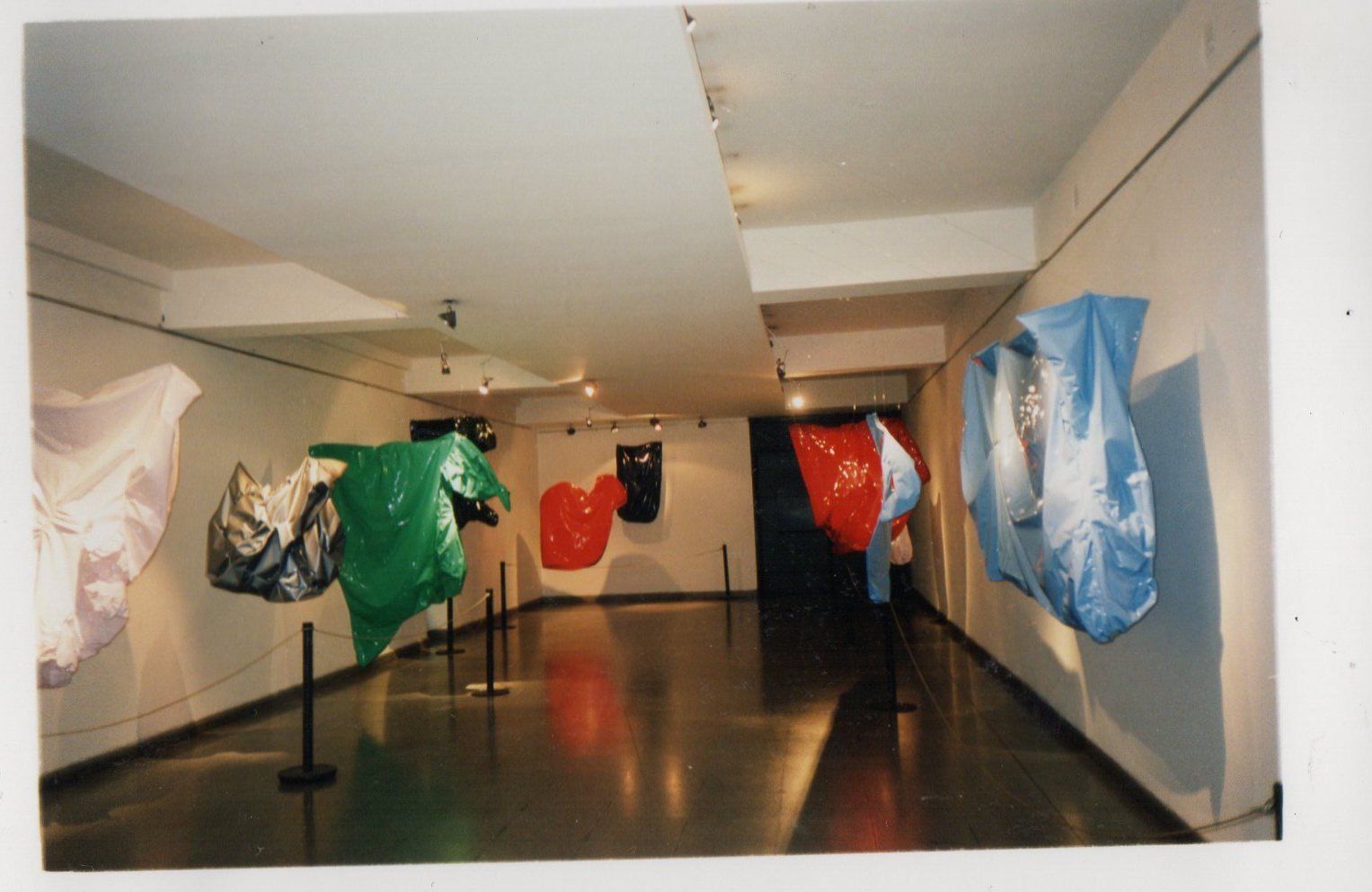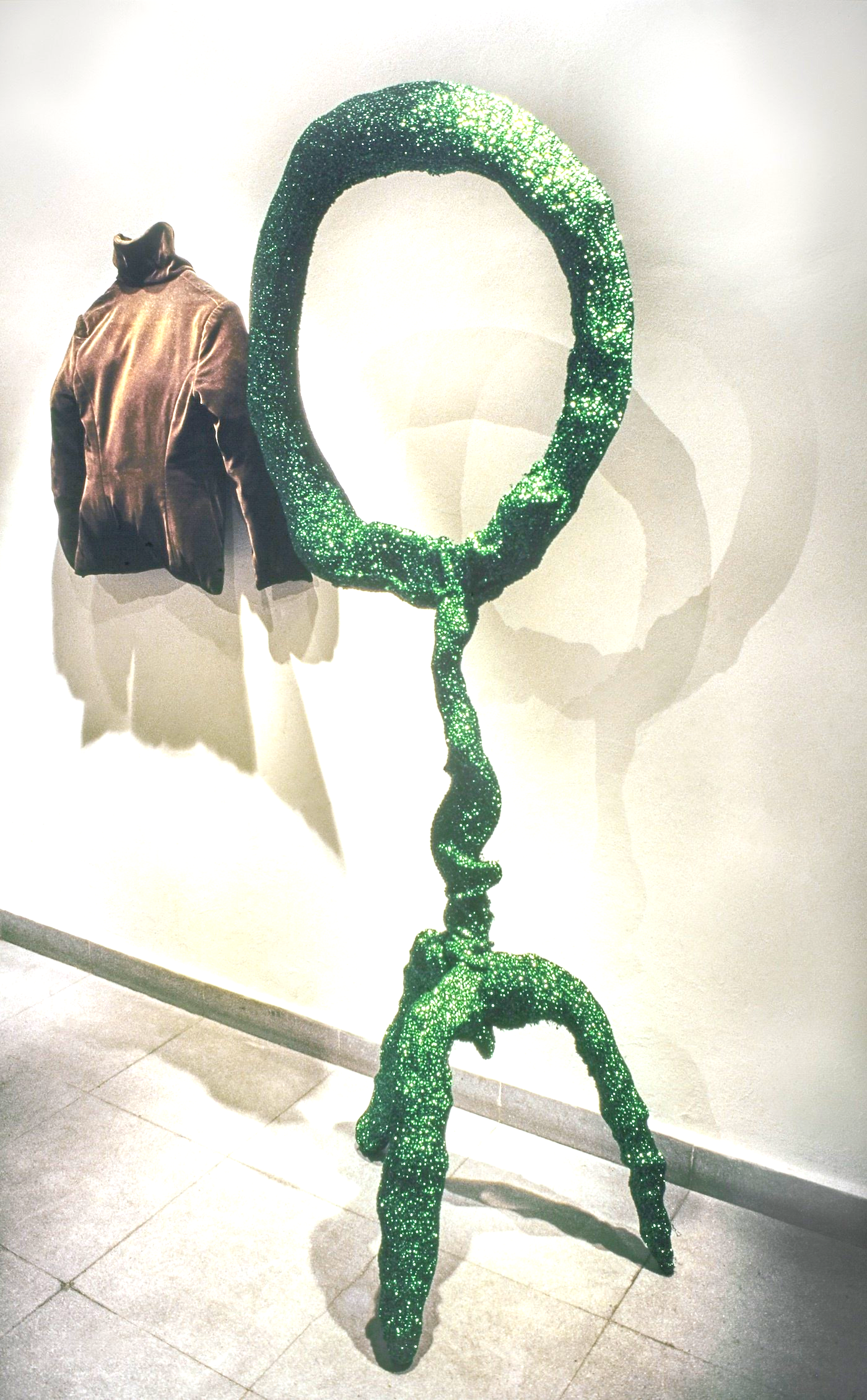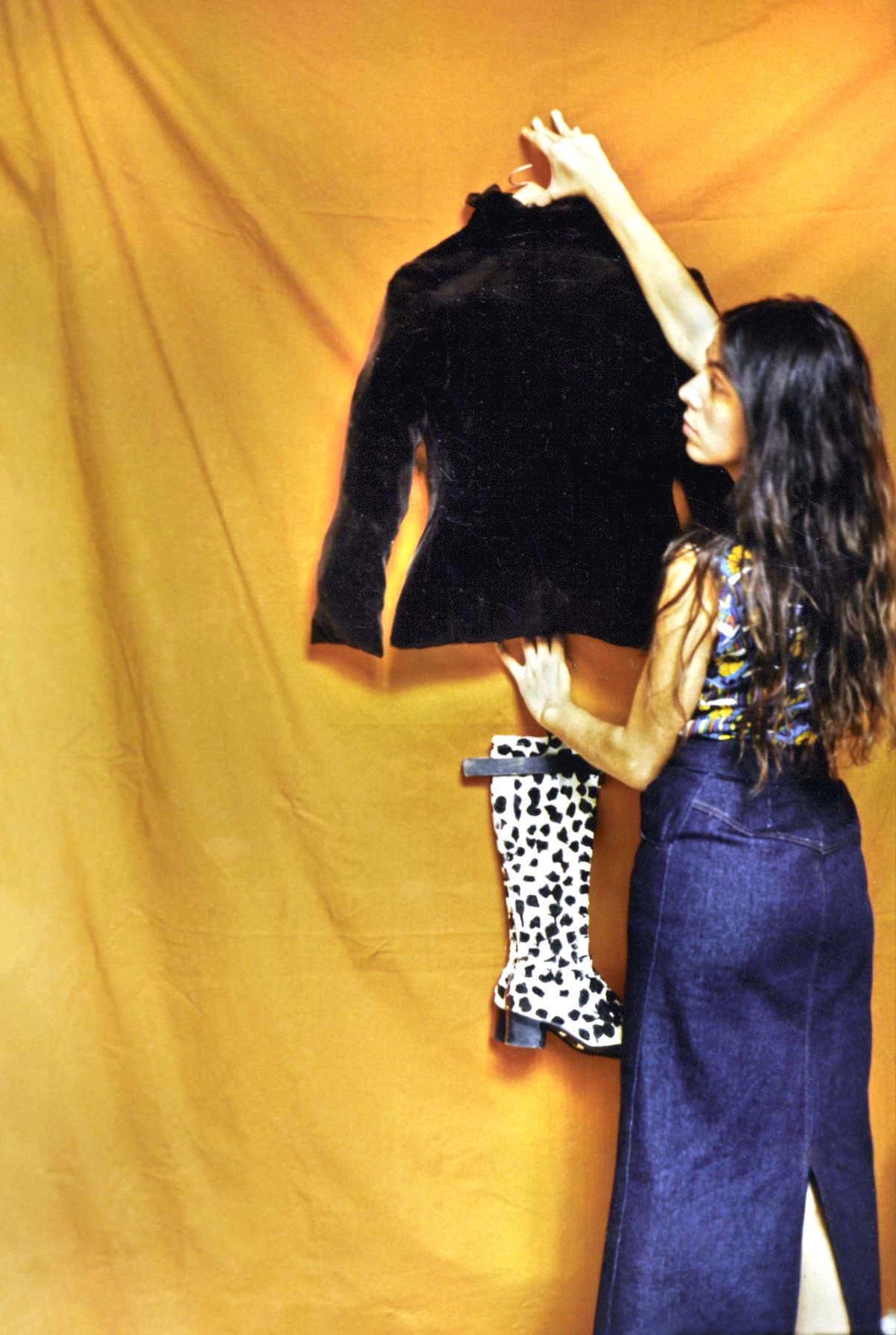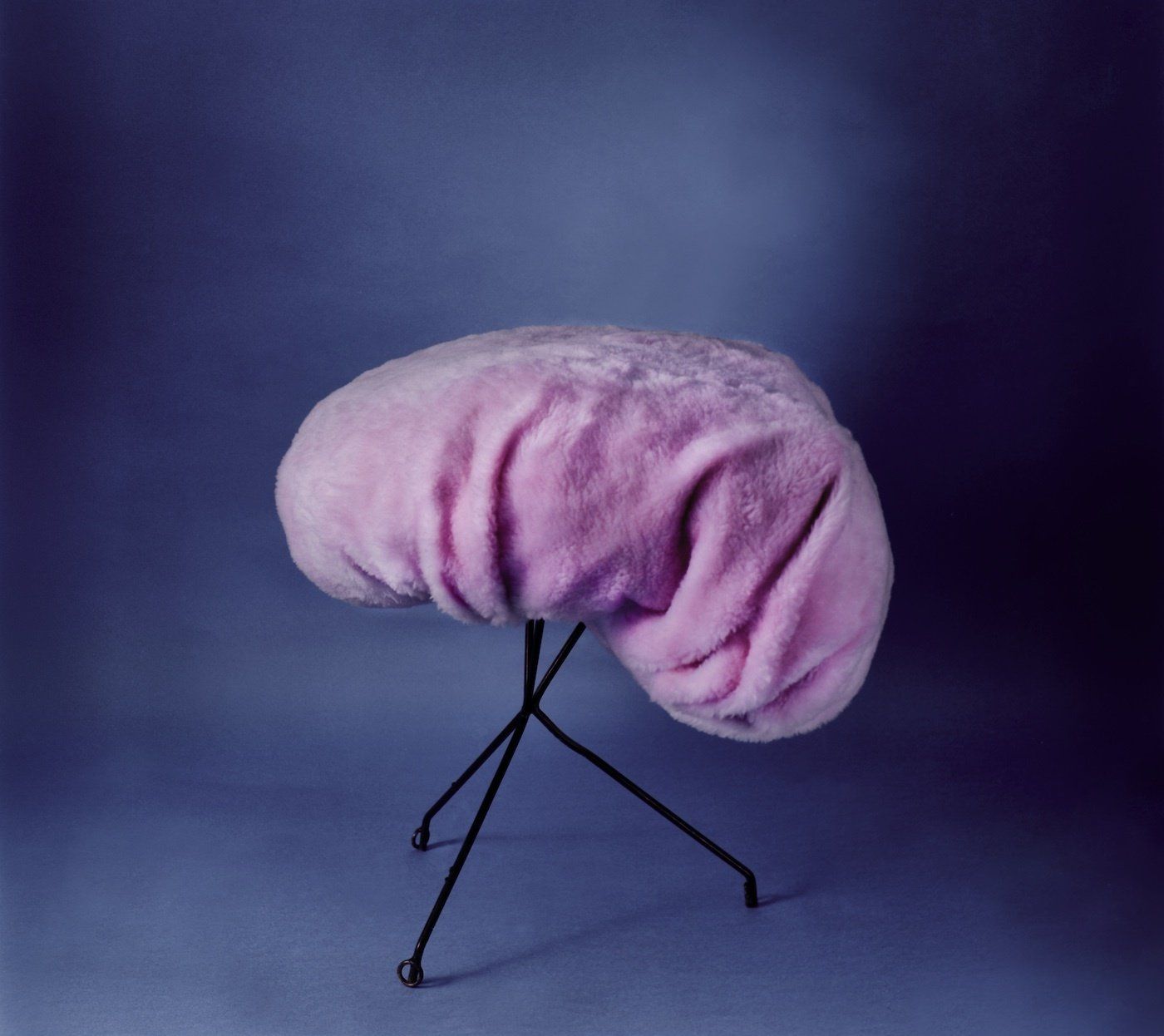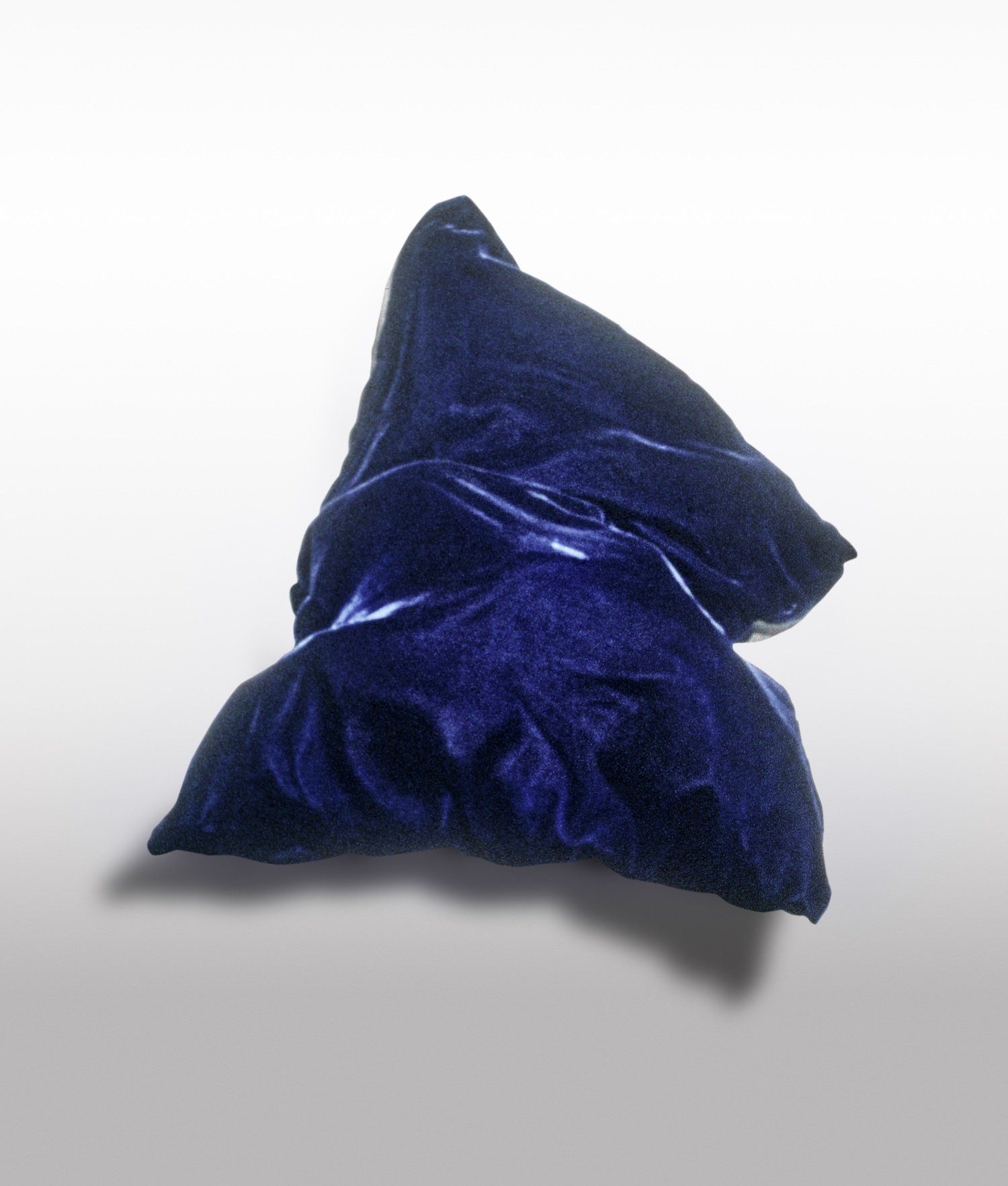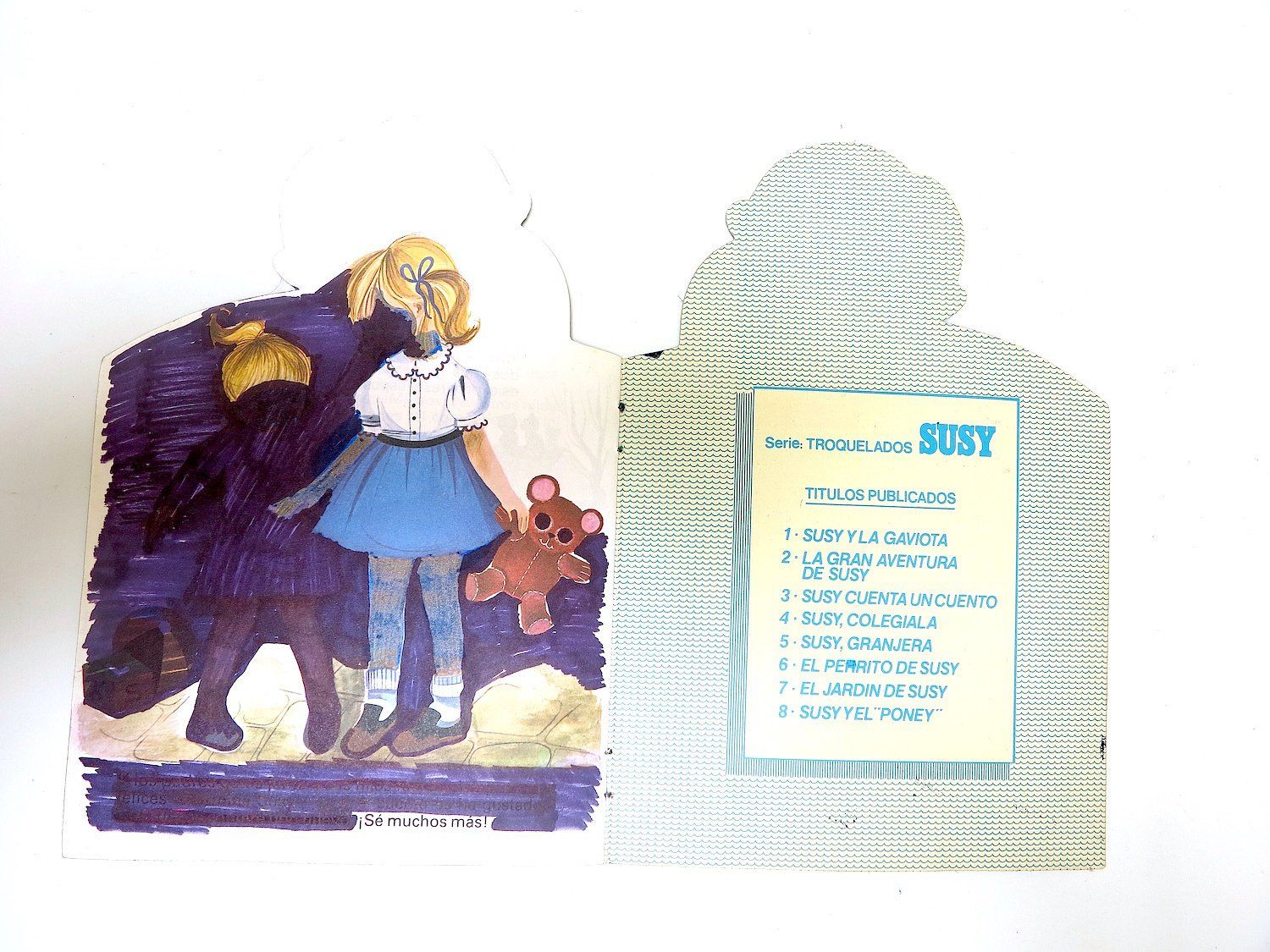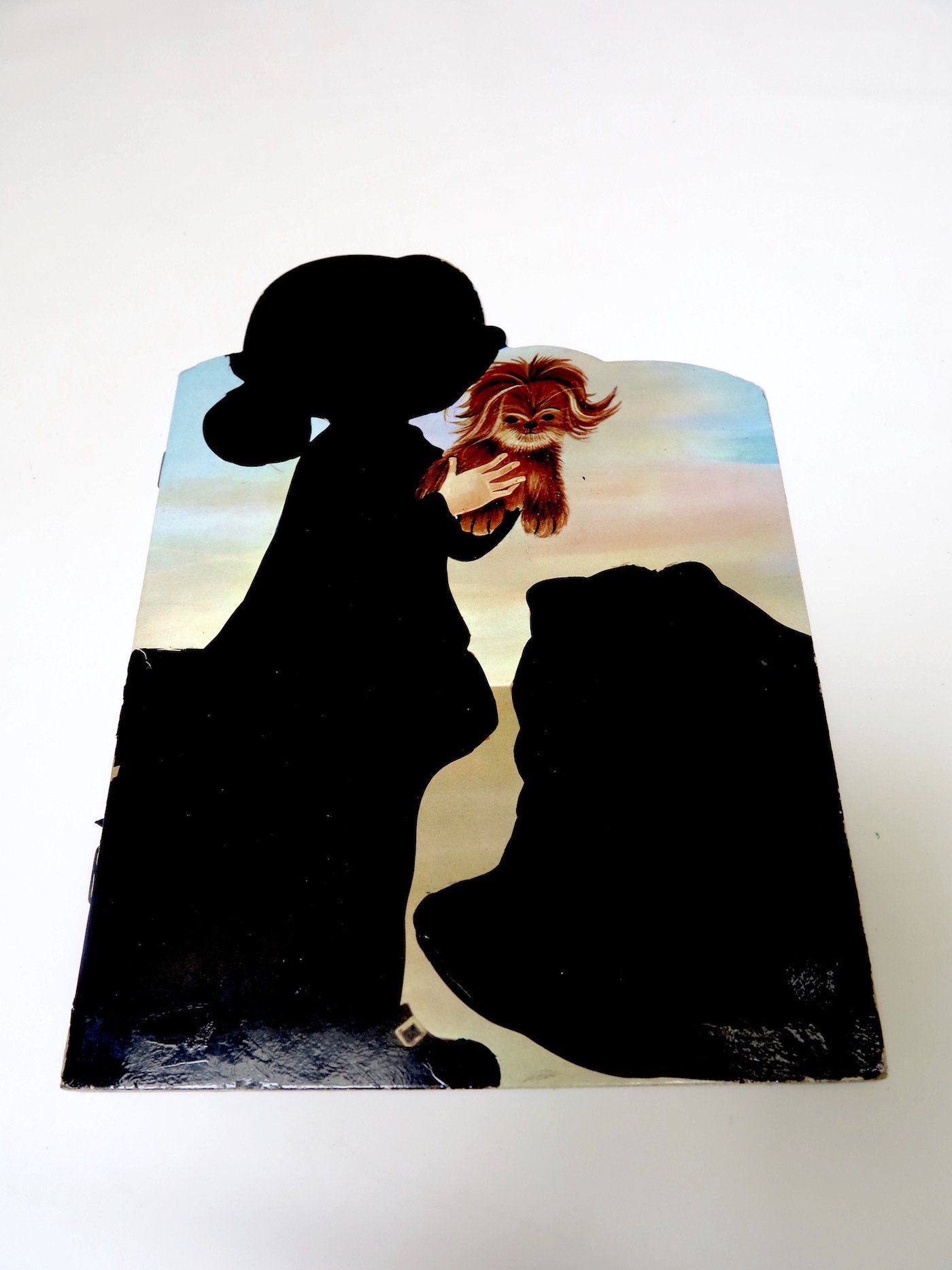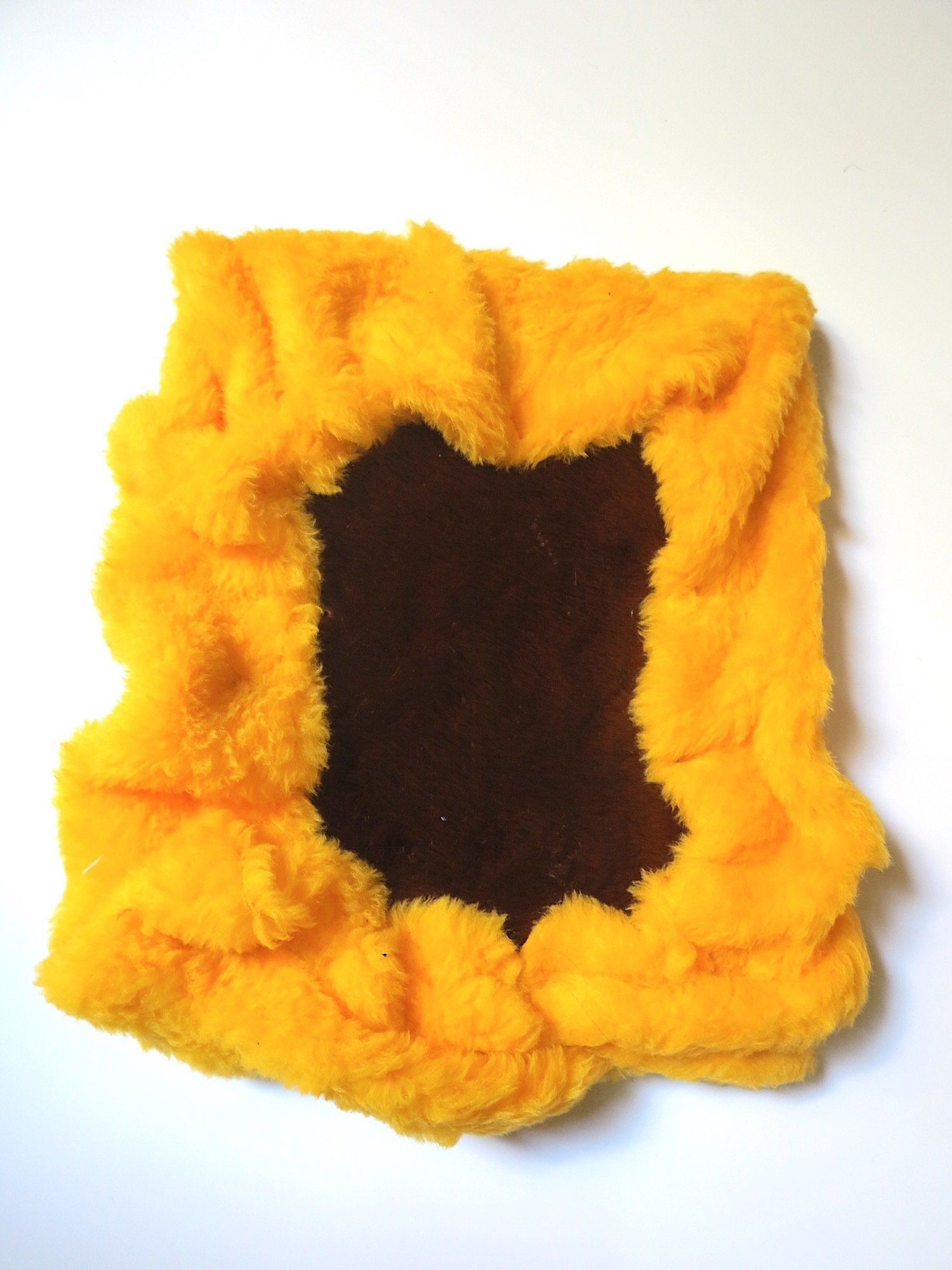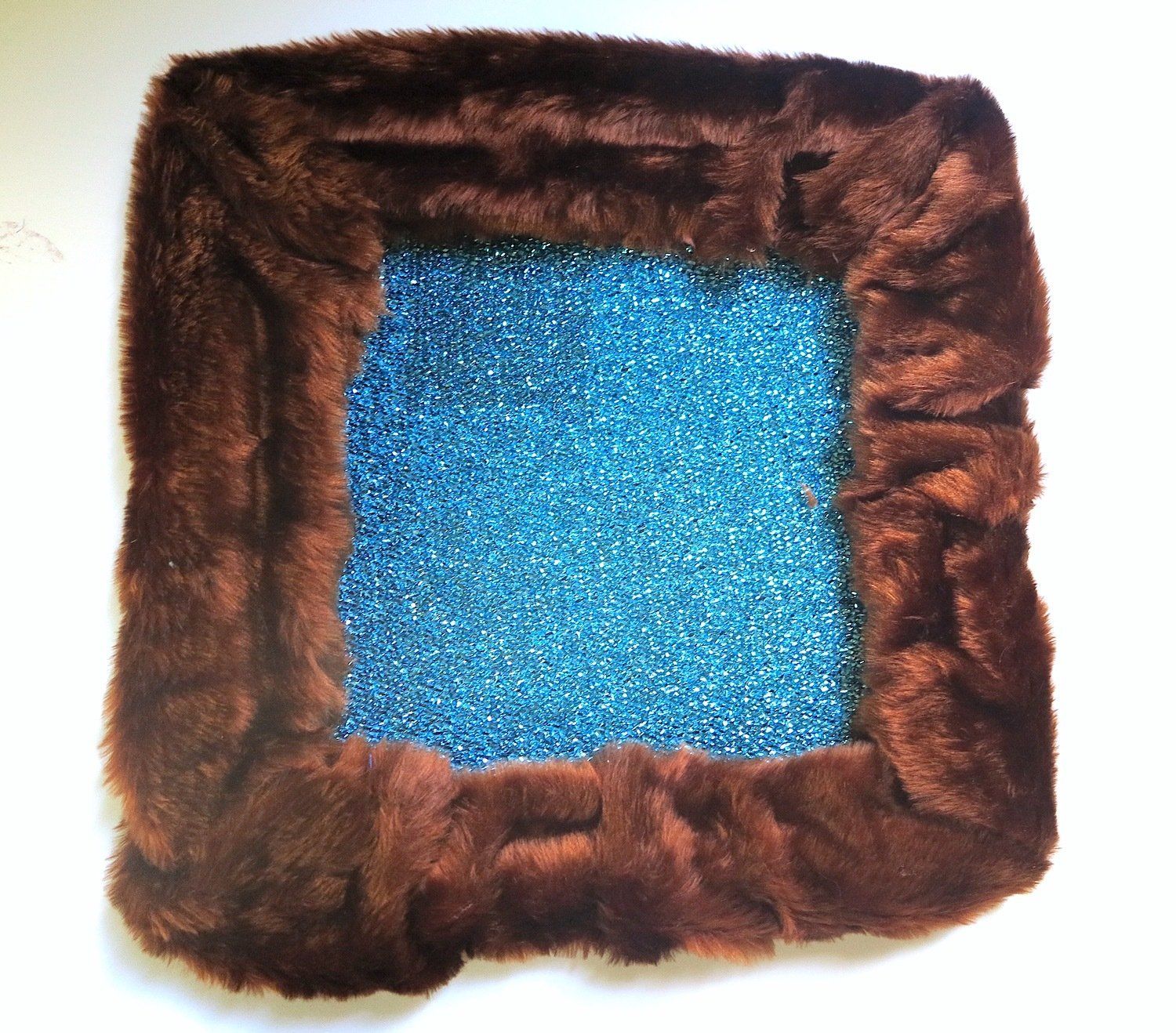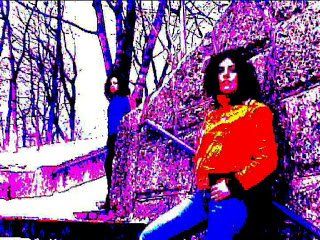wearable sculptures
2020 - 2021
PERFORMANCES
Installation in: "A Mirror of Fabrics", group exhibition curated by Constanza Martinez 2018.
Museo Mar, Mar del Plata Argentina. 2018
Formas para el sueño is an installation that transports us to instances related to pleasure.
An inside and an outside, separated by a wall of printed houses advertising a private neighborhood of Buenos Aires, in a large canvas, soft wall, which barely holds, but pretends to be huge and voracious.
If the spectator passes that instance, if he overcomes this wall, he can enjoy the fantasy created by the dream.
"My bodies" in the Ernesto de la Cárcova Museum are like a statement of time, in their materiality, metaphorical and realistic conception. It is like showing history from other points. Plastic against plaster. Strength against emptiness. Sculptures similar in their original colors, similar in their duration, similar in their valuation or neglect. It is the first time that my bodies are confronted with classical bodies. I believe that they enhance each other. When I visit the museum, I imagine this immediately, a body frieze is assembled in my head with works that I had and others that I made new to dialogue with those in the museum. Facing the David was a bit more complex because I had to devise a piece in relation to that sculpture and for that space. When I thought of the project I thought of Vero and her bodies. Without a body there is no existence".
THE LOVER THINGS
Isla flotante Gallery
2015
The Lover Things , Text by Maria Moreno.
Ariadna Pastorini has made us laugh by so thoroughly perverting the nature of anything at all, inflating landscapes and maps, making innards from hanging pieces of lycra, performing vinyl sacrifices with living room furniture as twisted and unstable as the institution of marriage for which it was conceived. Still a seamstress of horrors, she shows here majestic flaps, chiffon ghosts or ectoplasms, cheap fabrics that nonetheless symbolize luxury according to the fashion of the rolls of textiles in Deep Once (the textile district of Buenos Aires), industrial trimming where affordable translation means organza or chintz, a set of Elizabethan curtains freed of traditional support as if, through these forms, the elitist curtain of the opera house in any modern city were to declare: “I have already closed my amorous and rhythmic folds over dead Lear, I have dragged my velvet side over the floor of the most theater of all and received at my feet hundreds of flowers that the greatest divas would rather trample than take the trouble to gather. Now I want to be the work and not the frame, the flower and not the floor, the center and not the adornment. And, in my uplifting mutation, I relinquish the reactionary material that I inhabit to aspire to the plebeian shine of the nylon thread, the boundless invention of folds, the frills and draping to no purpose , hall or window, given over to the indefatigable madness of being just form, albeit magnificent form.”
TEMPLE
THE EQUILIBRIUM
Walden Gallery,
2017
Remarkable creator of riddles and paradoxes, after an imaginative creative process, Ariadna Pastorini has built through time an equally original and magnetic path, which keeps on revealing itself each time more surprising. Her production is, simultaneously, constant and new, since it maintains a continuous and stable line, which refuses to remain static, revealing at every instance new aspects and unexpected retreats. It is not easy to find the exact words to describe the security an artist transmits when he or she feels every artwork fits, or when the last one highlights the body of works. That is how the work of Pastorini can be seen, with a wide variety of new and previous pieces; this time, again, another imitative composition of herself, with the aura that comes with the crystallization of her mature work.
At her first solo exhibition at WALDEN,El equilibrio [Equilibrium], Ariadna Pastorini presents a well-nurtured body of works that displays her most recent production. Printed graphics, transparencies of different densities, shining and opaque qualities of the fabrics allow her to create various shapes that distinguish each and every single one of these pieces, according to the alliance of its own special characteristics. Ariadna Pastorini is precise in her way of composing, by keeping a pictorial criterion and, undoubtedly, a sense of non-sculpted volume, which gives the pieces a mutable condition. These artworks are strongly sensorial and underline the ludic process of their means of production.
http://www.waldengallery.com
Patricia Rizzo, Octubre 2016
THE INVITATION
Museo de la ciudad 2016
When I was asked to do something in the museum of the city, it occurred to me to play house.
For having a Pastorini museum, I selected some objects from the museum's vaults and some of mine for a sort of visual challenge.
I chose my rather playful sculptures, small objects and paintings that would confront rational classical sculptures, which appeared a perfect mix for me.
MUDABLES
FUNDACION OSDE 2016
Performance of an Art Installation
The artist created this installation in front of the public. She used several tissues, either suspended from the ceiling, fixed to the wall or layed out on the floor. The final result was completed by a visual setting in a storefront. The artwork was then ready to be viewed by all those passersby whom did not witness the very process of the installation.
The concept of „Mudables“
This installation derives from the idea of the artist as inexhaustible spring of creation.
To be human is being changeable (mudable), changing permanently. To be able to transform even the horizon.
To unite pieces that nobody can imagine being united.
To search incessantly for new forms. To try to stay within them, even if only for a short moment
To play with a perceptive system of colors.
Movements may help. Sometimes even to point of getting statical.
MUDABLE Concept
- In recent times I realize that when I create a work I never feel it is finished, I always want to change it.
I call this, The mutable concept.
Applicable to my installations, performances, and other works.
I think it is the essence of these times.
The ephemeral of material and form.
Sculptures created by the grouping of parts that continually change places.
Forest
FONDO NACIONAL DE LAS ARTES
I remember when I was a little girl I got lost in a forest with my family.
At nightfall it became infinite.
Some time later I went back to that forest and it seemed very small to me.
They say that in miniature values are magnified.
My little forest in the basement.
The deep forest is a state of the soul that comes to give us the value of intimate immensity.
The basement is dark, irrational, surrounded by entire land.
The forms do not depend on our desires.
My little forest in the basement.
In the basement there is a small inhabited forest.
As we approach it there may be forms that emit sounds, words, phrases and laughter.
At times they speak to us.
Will they accompany or scare us?
Poem for the exhibition by A P 2014
Planet Pastorini
It is the dissociation of matter.
The textile nature of forms.
What is animal and what is plant? We are all nature.
The forms are the same. The sensations, the perception, the touch, the space.
Some objects whispered to passers-by, creating a mysterious garden of perceptions.
In the sign of gold
Ortung III, im Zeichen des Goldes, Schwabach, Germany, 2003
The gold of their bodies. The passionate nature, travel transformers and sensual greed in front of the grounds and to the artistic subject, relate Ariadna Pastorini the French painter Paul Gaugin, overcoming differences of time and space. But what seems to bring them closer is the valuation of the body, glorified by both its ruddy presence in the works of Gauguin, as by the suggestive "unexcused" raised by each component of the work of pastorini.
Drawn to scissors and sewing machine, in its contours are looming trunks and limbs, just modeled by gathers, pleats and drapes. Despite the striking and bright texture of lambonería, the lightness and thinness with which these bodies materialize, as well as its clear condition of emptiness, evoke ghostly presences, which however do not accept their ethereal destination of imminent dissolution. It is impossible not to sense in them in the thousands of Argentines disappeared, that still today demanding their place in the memory of an entire people. It is impossible not to mention each and every one of the genocides that throughout history have attack against the integrity of the human body and soul.
Body, ritual and sacrifice are one when some of these forms built by Pastorini, reminiscent of a res open and hung on their hind legs, recalling the history of Argentina as a cattle country and the linking of this practice, not only with the economic activity, but also with a recurring tradition of violence and fratricidal struggles, in which their own methodologies have been filtered out of the slaughterhouse.
But also the reference expands and becomes universal when it is noted that these "existing", responding to their dual nature, hanging from a rope in a laundry in the garments made of fabric sewn together, but also "hanging by a thread", as fragile and vulnerable bodies wrapped in the evolution of life.
The visual richness of the material used and its referral to the gold, not only complies with the tribute to the artisans gilders of the city of Erlangen, but which brings both from the perceptual, as from the symbolic, toward a meaning, of which they are not absent the precious and the sacred, in its broader sense. Fate of Neoplatonism that uses the material splendour to transit the overcoming spiritual, through the artistic transformation.
Adriana L. Lauria. July 2003
We relate Pastorini's Goldkorper to an idea of Marcel Proust about the past hidden somewhere, "beyond the reach of the intellect, in some material object (in the sensation that that material object will give us) and which we do not suspect." And, we add that perhaps the future may also reside in those golden bodies.
Finally, we wonder if this change in artistic materiality is not signaling some ontological change. Or its necessity.
Mercedes Casanegra 2009
Titel hinzufügen
Souvenir d'Europe
Anyone who grew up in Argentina, as I did, was always at home in Europe. In elementary school, we learned that almost all of our ancestors had boarded ships that had left from some European port. In history class in high school, there was talk of Caesar and Louis XIV, of Napoleon and the German Empire. And in art school, the professors teach us based on models from the European ottocento. Therefore, many Argentines 'know' Europe, even if they have never been there. Even if this 'knowing' is essentially limited to postcard motifs.
Not long ago, here in Europe, I came across a larger number of such motifs, multicolored and abundantly boldly printed on artificial silk cloths. When I got hold of these mementos, probably from souvernir stores, I had the idea to vary them in my own way. I attacked one of them with acrylic paints, the other with a sewing machine. For me, these are by no means attacks on Europe's famous buildings and places, but an artistic attack on European clichés. One may find this brutal, I find them rather pleasurable.
Zimmer Belegt
Mariandl Hotel Munich, Germany
Room Occupied
What stays in a hotel room?
The guest doesn't, he occupies the room, the bed, the bathroom by distributing his belongings - and disappears. To meet people, to go out to eat, to have adventures.
What remains are his things, utensils, clothes.
I will occupy the room. Will transform the contents of a travel bag: Cut, sew down, fill. And occupy the bed, chest of drawers, closet, bathroom in the literal sense.
FLOATING
Centro cultural Rojas 1998
The equilibrium and the plan remain debris
They're vinyl sculptures that expand
geography and space. In the air,
in the mind, the clipped space, suspended
within a proportional and disparate succession
which is at the same time chosen.
Sebastian Linero
1998
Exhibition’s poem
Fantastic Zoology, 1996
Mun Gallery
Starting from the symbols of a poem, I organize my space, mixing the routine arrangement of my furniture, beloved colors, with a thought of radical change.
For this installation, I painted all my furniture white to let the stuffed objects, with all their color, form a mute tuning by resting on them.
The form taking the shape. Everything is a big game.
The Overwhelming Rest
Centro cultural Rojas 1995
My impression is that of an anxious oddity (I am timid): perverse changes in the functions of objects, sarcastic metonymic proposals, strangely familiar spaces, encrypted jokes make this hygienic environment remind of what it is obviously lacking: the perennial organic substance. The lining usually compulsively accompanies the volume it covers, these furniture and decorations, from which bumps and flaccid folds emerge, and where the nests of folds seem to hide a destabilizing void, pretend to be pregnant with something unknown: human? Humanoid? Extraterrestrial? Aesthetics more baroque than reality: a series of corpses invested in wars and epidemics returned to their country of origin, covered with black zippered plastic bags. The congested coat where the human skin was replaced by that of a cow, points to a fragmented torso. The butcher's hook is slightly displaced and there is an unusual bundle hanging, perhaps an bowel from Lycra.
The small tables, which are uniform due to the nile green colour (identical to that of the surgeon's coats) and their serial arrangement, refer to the aseptic area of a hospital.
Therefore, each of the chairs in which Ariadna invites us to "sit" one by one, even if the totem figure of La Parca, El Capuchino or El Verdugo draws our gaze like a magnet, they can only belong to the amphitheatre of a theatre of operations. It is an invitation to a vinyl sacrifice in which the traditional public space has been replaced by a part of the living room, this hybrid space between the entrance, where the coats are hung and the first greetings exchanged, and that of the family dinner ceremony.
To close the curtain, you have to try a little potion, nobody enters without preparing for the overflowing silence that, when completely overflowing, loses its limits and can come to eternal rest.
But everything is so pleasant, so inviting and seems so innocent in the silver packaging of the armchairs and the gold packaging of the wall, in the combed turquoise carpet, united by a very discreet harmony, as if we had the perspective of the inside of a gift box.
Or the front of the house with sweets that tempted Hänsel and Gretel when they ignored the witch's plan to lock them up and fatten them before they flooded the rest and turned them into lunch.
María Moreno 1994 Exhibition’s text
An observer of fashion, Pastorini operates in a world marked by consumerism, placing herself in a neo-pop al uso nostro that rescues the strategy of recycling, the one that thirty years ago produced grafts and inconsistencies of style in many middle-class houses in Argentina that sought to be in tune with the times. Hence its nostalgic inflection and its local flavor.
Artist books
Susi and the shadows is a series of books from 1990.
Children's books intervened pictorially and textually. They are minimal stories within the history of the book.
90's object painting
Objects of pictorial format made on canvas on a wooden base.
Sensitive geometric exercises.
Made continuously in the 90's.
videos
Series of videos made during the time I lived in Germany, in a context of migration 2001 to 2004. .
videos of seconds
- video series of seconds made in the year 2001.
- Seconds of occio.
Paintings
Ariadna Pastorini overpaints classical paintings from various epochs on the sleeves of vinyl records. Often she leaves only details of the original painting. 2006 to 2020.




